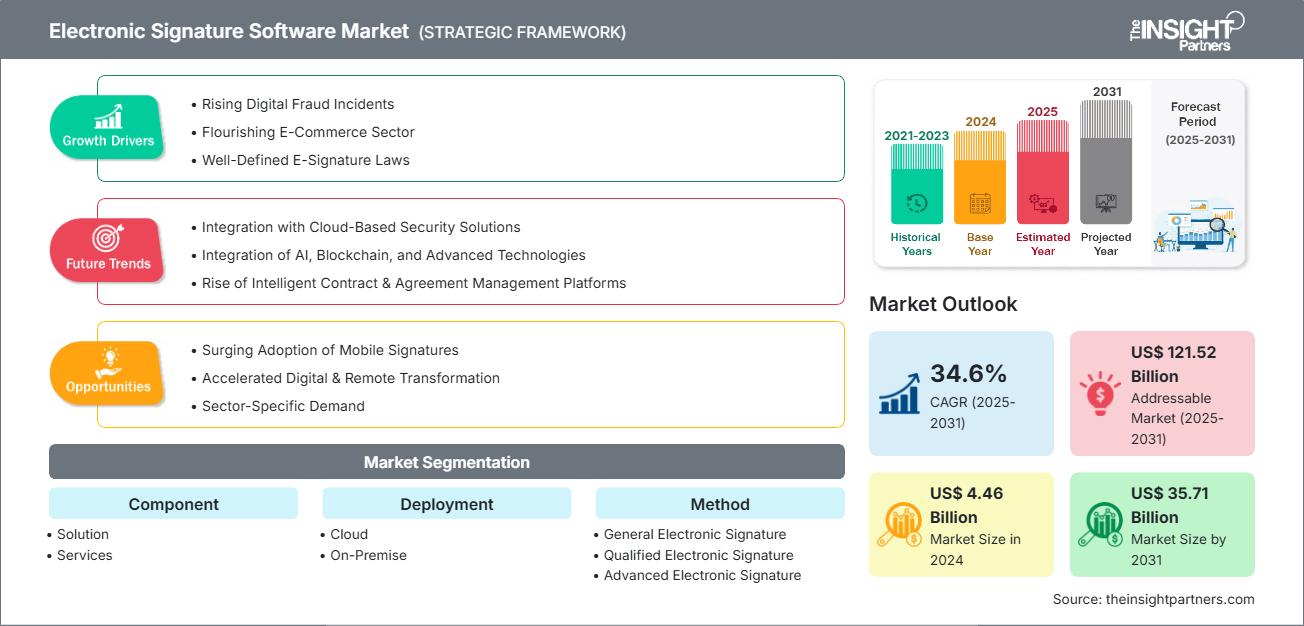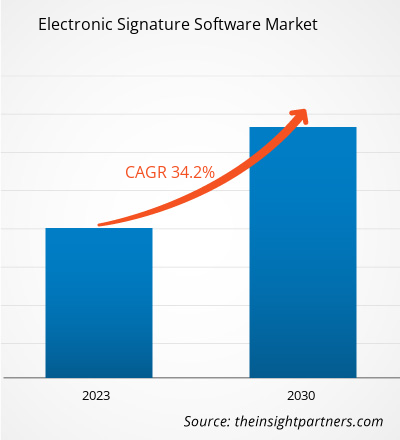[Rapporto di ricerca] Il mercato dei software per la firma elettronica è stato valutato a 3,3 miliardi di dollari nel 2022 e si prevede che raggiungerà i 35,7 miliardi di dollari entro il 2030; si prevede che registrerà un CAGR del 34,2% dal 2022 al 2030.
Prospettiva dell'analista:
Le firme elettroniche, come le firme cloud, sono considerate il tipo di firma elettronica più sicuro al mondo. Quando un'azienda o un individuo necessita del massimo livello di garanzia per identificare un firmatario, può proteggere la propria transazione o conformarsi alle leggi locali optando per una firma elettronica che utilizza un'identità digitale verificata da una terza parte attendibile. Alcuni dei fattori chiave che contribuiscono alla crescita del mercato dei software per la firma elettronica includono la crescente digitalizzazione, i progressi tecnologici e la crescente attenzione delle aziende alla fornitura di servizi end-to-end migliori. A livello globale, la produzione, la BFSI, l'industria farmaceutica, le agenzie governative e il settore legale sono alcuni dei principali settori di utilizzo finale che sono in prima linea nella spesa per software di firma elettronica a livello mondiale.
Panoramica del mercato dei software di firma elettronica:
Una firma elettronica è un modo efficace e legale per firmare rapidamente documenti elettronici. È un sistema sicuro e affidabile che può sostituire una firma autografa in molti processi. La firma elettronica offre una sicurezza superiore sia alla parte che firma i documenti sia a quella che li riceve. I documenti firmati elettronicamente hanno un potenziale maggiore nel settore legale, il che rappresenta un fattore importante a supporto della crescita del mercato dei software di firma elettronica. Il software di firma elettronica offre diversi vantaggi che consentono alle aziende di semplificare il flusso di lavoro. I vantaggi delle firme elettroniche includono, tra gli altri, una maggiore velocità aziendale, una migliore accuratezza dei documenti, l'ottimizzazione di costi e tempi e un servizio clienti migliorato.
Personalizza questo rapporto in base alle tue esigenze
Potrai personalizzare gratuitamente qualsiasi rapporto, comprese parti di questo rapporto, o analisi a livello di paese, pacchetto dati Excel, oltre a usufruire di grandi offerte e sconti per start-up e università
Mercato del software per la firma elettronica: Approfondimenti strategici

-
Ottieni le principali tendenze chiave del mercato di questo rapporto.Questo campione GRATUITO includerà l'analisi dei dati, che vanno dalle tendenze di mercato alle stime e alle previsioni.
Driver di mercato del software di firma elettronica:
Crescente adozione di tecnologie digitali da parte delle imprese
Il software di firma elettronica sta assistendo a una crescente adozione in tutte le imprese pubbliche e private. Banche nazionali e internazionali, enti governativi, piccole e medie imprese e altri richiedono firme digitali per proteggere e controllare i dati critici. Diverse aziende utilizzano le firme digitali per prevenire violazioni dei dati e garantire interazioni affidabili con i propri partner commerciali e le procedure interne. Questo è ulteriormente supportato dai consumatori più giovani, che stanno integrando sempre più soluzioni di firma digitale nella loro vita quotidiana. Ad esempio, secondo una ricerca Adobe 2020, oltre il 61% dei clienti Adobe nell'area APAC era costituito da millennial dal 2019 al 2020.
Inoltre, le aziende con dipendenti e filiali dislocate in diverse sedi in tutto il mondo stanno aumentando l'utilizzo delle firme elettroniche nei loro processi. Ciò le aiuta a ridurre i tempi eliminando la necessità di stampare e trasportare documenti per l'approvazione. Inoltre, non è facile archiviare e recuperare documenti fisici a lungo termine. Secondo il rapporto della Federazione delle Camere di Commercio e dell'Industria Indiane (FICCI) di ottobre 2023, circa il 35% degli intervistati ha segnalato una riduzione dei costi operativi annuali dell'11-20% grazie alla digitalizzazione. Le aziende stanno trasformando il proprio business in digitale per competere efficacemente nell'era digitale. Pertanto, la crescente adozione di tecnologie digitali da parte delle imprese guida la crescita del mercato dei software per la firma elettronica.
Analisi del segmento di mercato dei software per la firma elettronica:
Il mercato dei software per la firma elettronica è classificato in base a componenti, distribuzione, metodo e utente finale. In base alla distribuzione, il mercato dei software per la firma elettronica si divide in cloud e on-premise. In base all'offerta, il mercato dei software per la firma elettronica si divide in soluzioni e servizi. In base al metodo, il mercato dei software per la firma elettronica è classificato in firma elettronica generale, firma elettronica qualificata e firma elettronica avanzata. In base all'utente finale, il mercato dei software per la firma elettronica è classificato in BFSI, farmaceutico, manifatturiero, agenzie governative, legale e altri. In base all'area geografica, il mercato è segmentato in cinque regioni principali, tra cui Nord America, Asia-Pacifico, Europa, Medio Oriente e Africa e Sud America.
Le aziende nell'attuale scenario di mercato si stanno concentrando sull'adozione di soluzioni convenienti che offrano funzionalità aggiuntive con una maggiore integrità dei dati e una maggiore trasparenza. Diverse entità in tutto il mondo utilizzano soluzioni di firma elettronica. Ad esempio, nel novembre 2023, Lion Travel ha adottato la soluzione di firma elettronica DottedSign che aiuta l'azienda a ottenere un metodo più efficiente, conveniente e sostenibile per la firma dei contratti di viaggio, con un risparmio annuo di carta previsto di circa 4,5 tonnellate. Pertanto, tali casi stimolano la crescita del mercato dei software di firma elettronica per il segmento delle soluzioni.
Analisi regionale del mercato dei software di firma elettronica:
Il mercato europeo dei software di firma elettronica è stato valutato a 1,01 miliardi di dollari nel 2022 e si prevede che raggiungerà gli 11,03 miliardi di dollari entro il 2030; si prevede che registrerà un CAGR del 34,7% dal 2022 al 2030. Il mercato dei software di firma elettronica in Europa è segmentato in Francia, Germania, Russia, Italia, Regno Unito e resto d'Europa. Nella legislazione europea, le firme elettroniche sono state riconosciute per la prima volta tramite la direttiva su un quadro comunitario per le firme elettroniche, adottata nel 1999. In Europa, nel luglio 2016, il Regolamento sull'identificazione elettronica e i servizi fiduciari (eIDAS) ha stabilito una struttura giuridica per le firme e i documenti elettronici in tutta l'Unione Europea (UE). Dal luglio 2016, le firme elettroniche nella regione sono disciplinate dal Regolamento sull'identificazione elettronica e i servizi fiduciari (eIDAS); Offre un contesto normativo direttamente applicabile a tutti gli Stati membri dell'UE per consentire interazioni elettroniche fluide e sicure tra cittadini, imprese e autorità pubbliche. Ciò offre inoltre alle aziende un contesto giuridico prevedibile per sviluppare ed espandere l'uso delle firme elettroniche nella regione.
Analisi dei principali attori:
L'analisi del mercato dei software per la firma elettronica si basa sulle performance annuali di importanti attori come Adobe Inc.; Docusign, Inc.; Esign Genie; HID Global; Legalesign Limited; OneSpan; RPost; Thales SA; U-SIGN-IT; e Zoho Corporation. Sono stati analizzati diversi altri importanti attori del mercato dei software per la firma elettronica per ottenere una visione olistica del mercato e del suo ecosistema.
Approfondimenti regionali sul mercato del software per la firma elettronica
Le tendenze regionali e i fattori che influenzano il mercato del software per la firma elettronica durante il periodo di previsione sono stati ampiamente spiegati dagli analisti di The Insight Partners. Questa sezione illustra anche i segmenti e la geografia del mercato del software per la firma elettronica in Nord America, Europa, Asia-Pacifico, Medio Oriente e Africa, America meridionale e centrale.
Ambito del rapporto di mercato del software per la firma elettronica
| Attributo del rapporto | Dettagli |
|---|---|
| Dimensioni del mercato in 2024 | US$ 4.46 Billion |
| Dimensioni del mercato per 2031 | US$ 35.71 Billion |
| CAGR globale (2025 - 2031) | 34.6% |
| Dati storici | 2021-2023 |
| Periodo di previsione | 2025-2031 |
| Segmenti coperti |
By Componente
|
| Regioni e paesi coperti |
Nord America
|
| Leader di mercato e profili aziendali chiave |
|
Densità degli operatori del mercato del software per la firma elettronica: comprendere il suo impatto sulle dinamiche aziendali
Il mercato dei software per la firma elettronica è in rapida crescita, trainato dalla crescente domanda degli utenti finali, dovuta a fattori quali l'evoluzione delle preferenze dei consumatori, i progressi tecnologici e una maggiore consapevolezza dei vantaggi del prodotto. Con l'aumento della domanda, le aziende stanno ampliando la propria offerta, innovando per soddisfare le esigenze dei consumatori e sfruttando le tendenze emergenti, alimentando ulteriormente la crescita del mercato.

- Ottieni il Mercato del software per la firma elettronica Panoramica dei principali attori chiave
Sviluppi recenti:
Le aziende del mercato dei software per la firma elettronica si concentrano su strategie sia inorganiche che organiche per la crescita aziendale. Di seguito sono elencati alcuni recenti sviluppi chiave del mercato da parte dei principali attori del mercato dei software per la firma elettronica sopra menzionati:
- Nel 2023, Adobe Inc. ha integrato Acrobat Sign con Salesforce per aiutare le organizzazioni a operare più rapidamente con firme elettroniche affidabili. Acrobat Sign offre ai suoi clienti vantaggi consentendo loro di firmare in pochi secondi da qualsiasi dispositivo, aumentando la produttività di tutti i soggetti coinvolti nel processo di approvazione.
- Nel 2023, DocuSign Inc. ha lanciato una soluzione di verifica dell'identità basata sull'intelligenza artificiale per condurre controlli biometrici. Aiuta i firmatari a presentare fisicamente documenti di identità validi durante il processo di firma.
- Analisi storica (2 anni), anno base, previsione (7 anni) con CAGR
- Analisi PEST e SWOT
- Valore/volume delle dimensioni del mercato - Globale, Regionale, Nazionale
- Industria e panorama competitivo
- Set di dati Excel
Report recenti
Rapporti correlati
Testimonianze
Motivo dell'acquisto
- Processo decisionale informato
- Comprensione delle dinamiche di mercato
- Analisi competitiva
- Analisi dei clienti
- Previsioni di mercato
- Mitigazione del rischio
- Pianificazione strategica
- Giustificazione degli investimenti
- Identificazione dei mercati emergenti
- Miglioramento delle strategie di marketing
- Aumento dell'efficienza operativa
- Allineamento alle tendenze normative






















 Ottieni un campione gratuito per - Mercato del software per la firma elettronica
Ottieni un campione gratuito per - Mercato del software per la firma elettronica